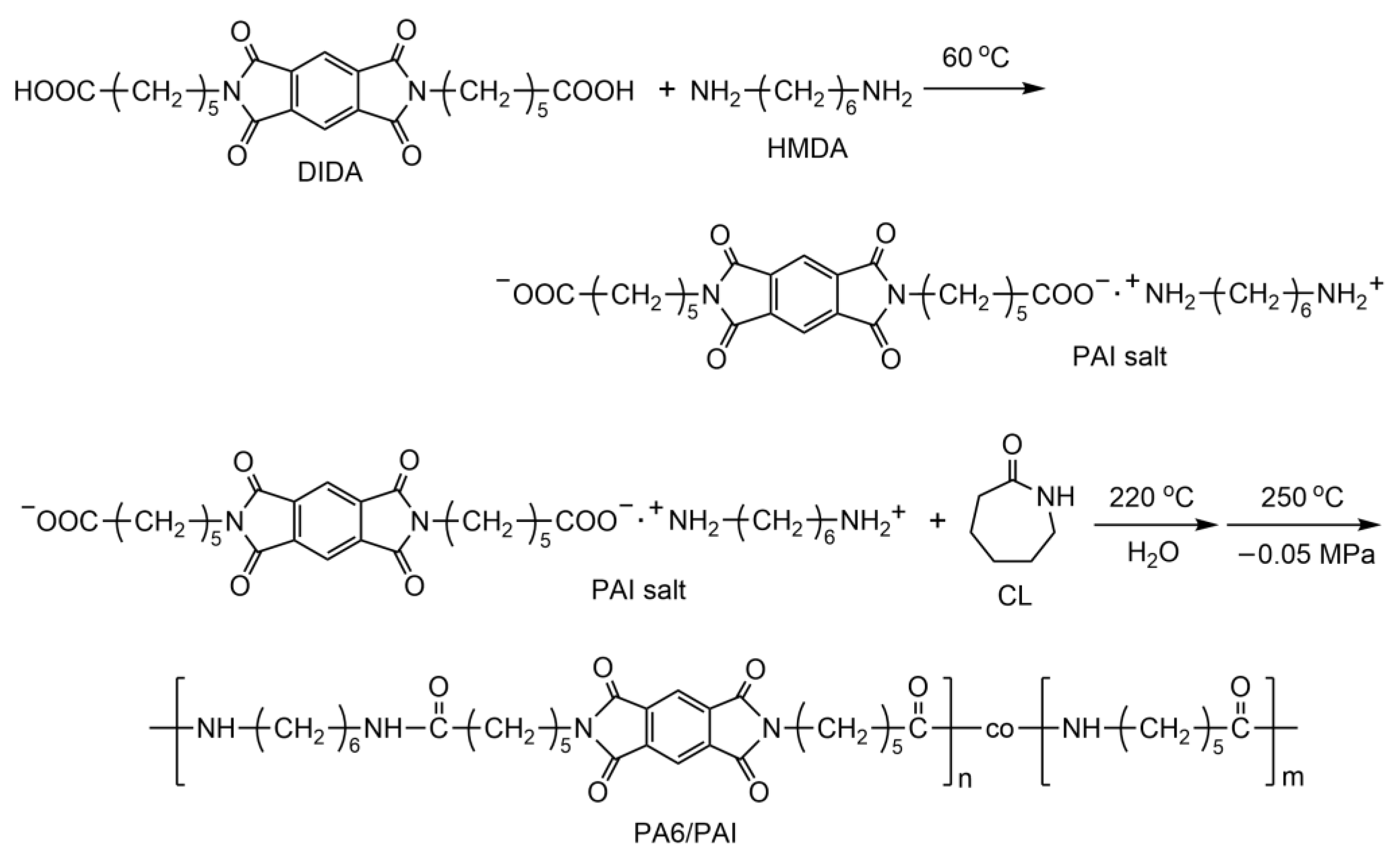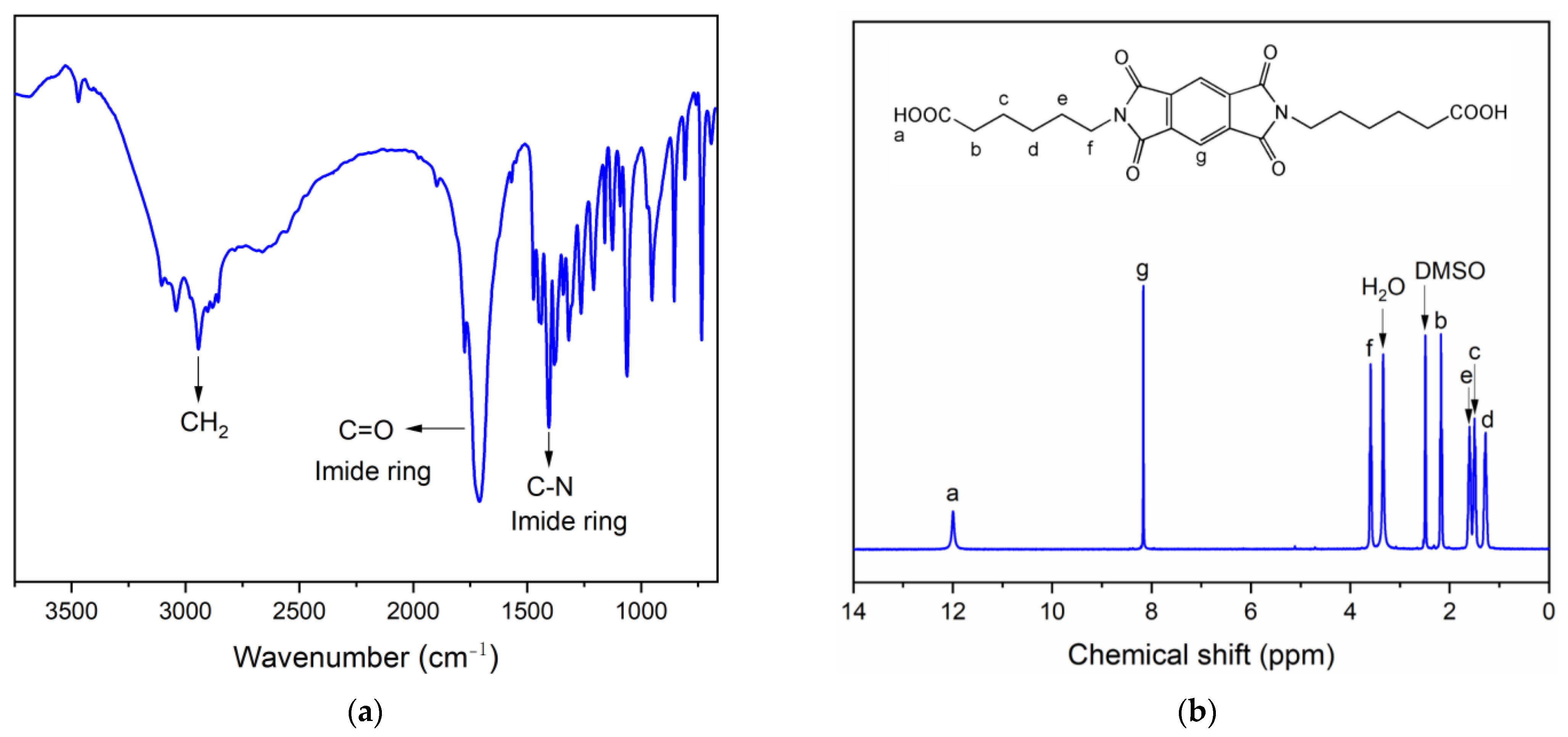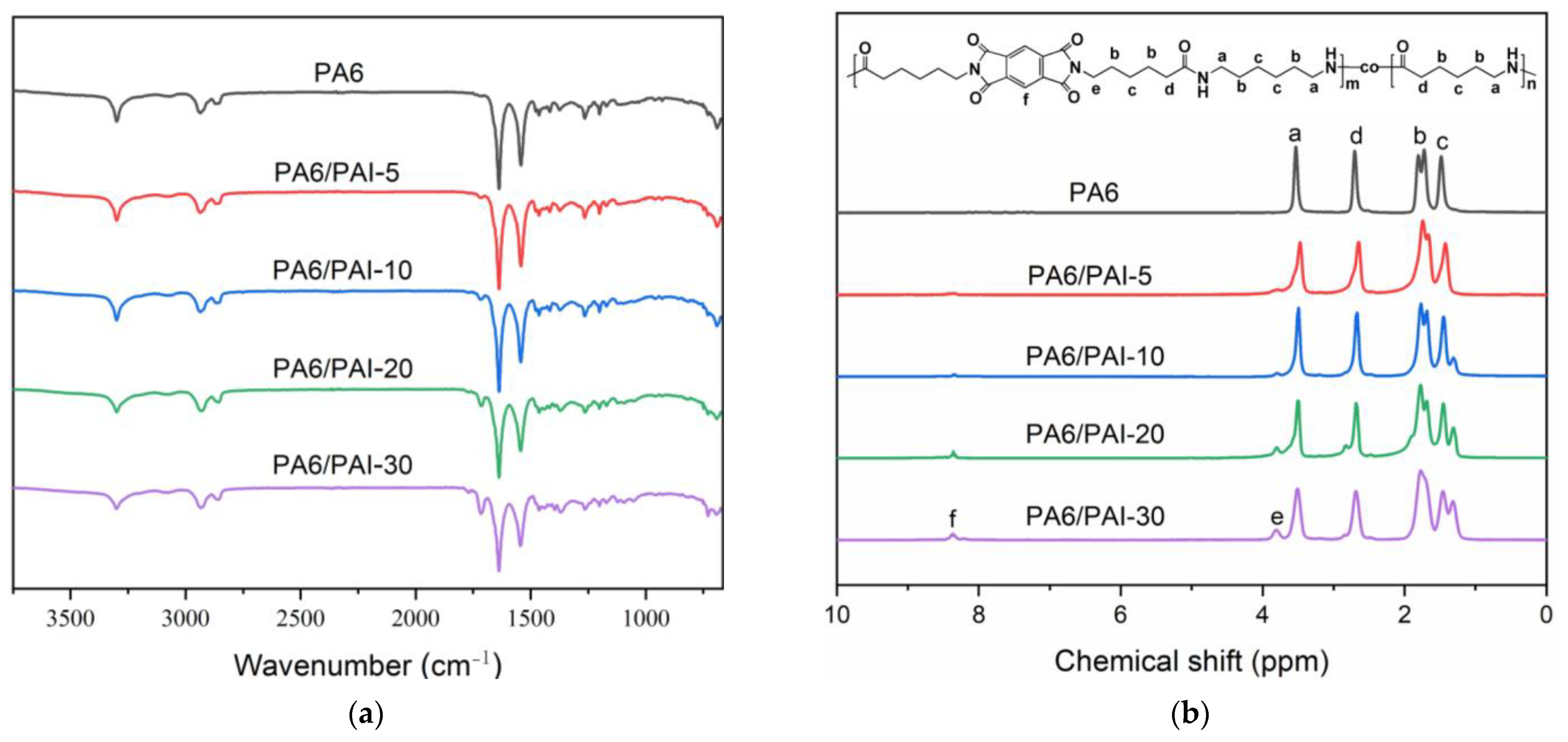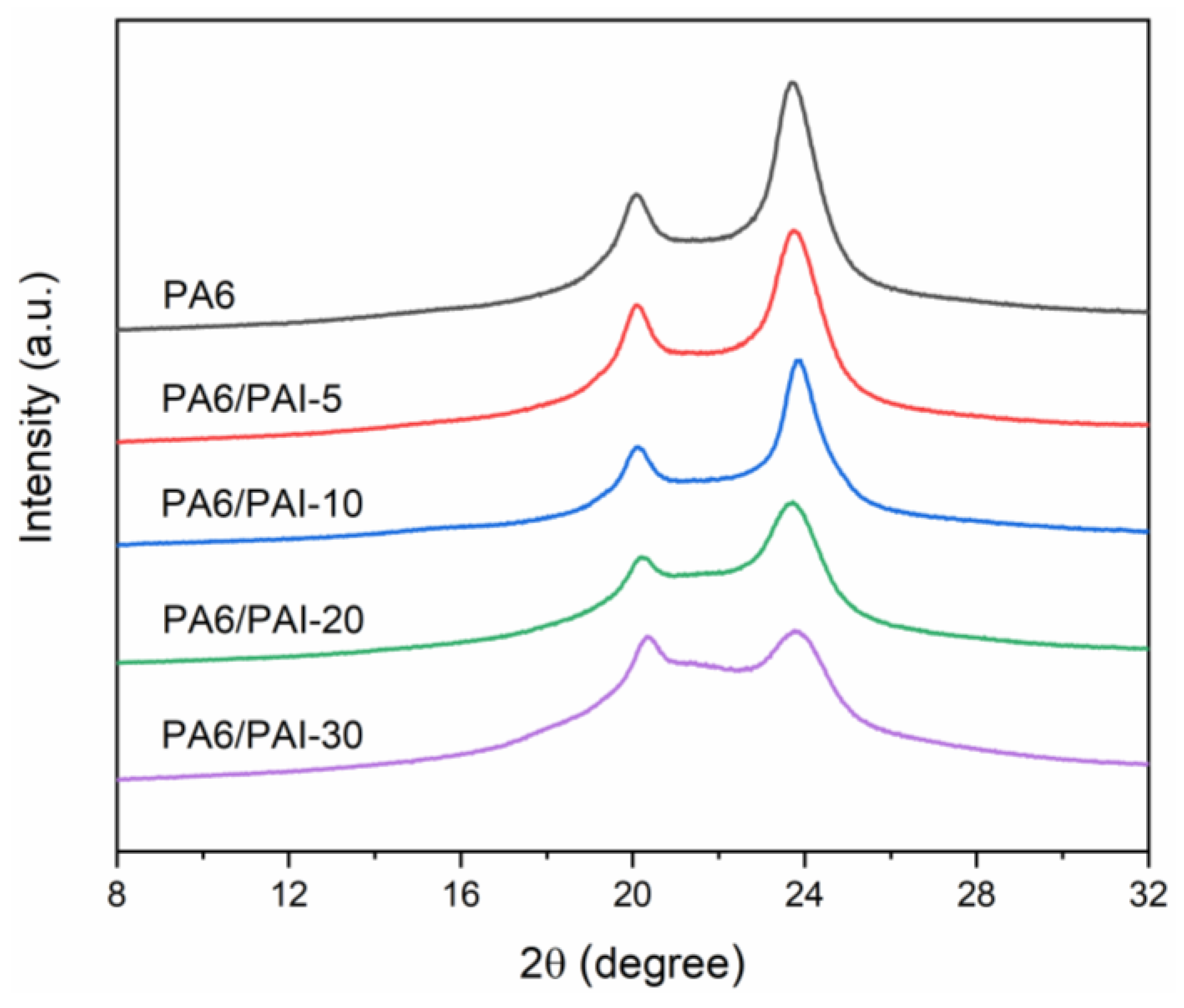Synthesis and Properties of Polyamide 6 Random Copolymers Containing an Aromatic Imide Structure
Abstract
:1. Introduction
2. Materials and Methods
2.1. Materials
2.2. Synthesis of DIDA Monomer
2.3. Synthesis of PAI Salt
2.4. Synthesis of PA6/PAI Random Copolymers
2.5. Characterization
3. Results and Discussion
3.1. Structure Characterization of DIDA Monomer
3.2. Structure Characterization of PA6/PAI Random Copolymers
3.3. Thermal Properties and Crystallization Behaviors
3.4. Rheological Properties
3.5. Mechanical Properties
3.6. Dielectric Properties
4. Conclusions
Author Contributions
Funding
Institutional Review Board Statement
Informed Consent Statement
Data Availability Statement
Conflicts of Interest
References
- Goh, P.S.; Ismail, A.F. Chemically functionalized polyamide thin film composite membranes: The art of chemistry. Desalination 2020, 495, 114655. [Google Scholar] [CrossRef]
- Pervaiz, M.; Faruq, M.; Jawaid, M.; Sain, M. Polyamides: Developments and applications towards next-generation engineered plastics. Curr. Org. Synth. 2017, 14, 146–155. [Google Scholar] [CrossRef]
- Varghese, M.; Grinstaff, M.W. Beyond nylon 6: Polyamides via ring opening polymerization of designer lactam monomers for biomedical applications. Chem. Soc. Rev. 2022, 51, 8258–8275. [Google Scholar] [CrossRef] [PubMed]
- Wang, C.H.; Zhang, Y.W.; Yi, Y.; Lai, D.W.; Yang, J.; Wang, W.Z. Thermal, morphological and mechanical properties of glass fiber reinforced star-branched polyamide 6. Polym. Composite. 2022, 43, 1617–1625. [Google Scholar] [CrossRef]
- Fu, X.B.; Yao, C.G.; Yang, G.S. Recent advances in graphene/polyamide 6 composites: A review. RSC Adv. 2015, 5, 61688–61702. [Google Scholar] [CrossRef]
- Zierdt, P.; Mitzner, E.; Gomoll, A.; Theumer, T.; Lieske, A. Synthesis of polyamide 6/11 copolymers and their use as matrix polymer in wood-plastic composites. J. Appl. Polym. Sci. 2016, 133, 44155. [Google Scholar] [CrossRef]
- Bertolla, M.; Cecchetto, M.; Comotto, M.; Dal Moro, A. Comparison of the properties of a random copolymer and a molten blend PA6/PA6.9. Polymers 2022, 14, 4115. [Google Scholar] [CrossRef]
- Cakir, S.; Eriksson, M.; Martinelle, M.; Koning, C.E. Multiblock copolymers of polyamide 6 and diepoxy propylene adipate obtained by solid state polymerization. Eur. Polym. J. 2016, 79, 13–22. [Google Scholar] [CrossRef]
- Yang, Y.Y.; Kong, W.B.; Yuan, Y.; Zhou, C.L.; Cai, X.F. Structure-properties relationships of novel poly(carbonate-co-amide) segmented copolymers with polyamide-6 as hard segments and polycarbonate as soft segments. J. Mol. Struct. 2018, 1157, 52–60. [Google Scholar] [CrossRef]
- Ai, T.H.; Zou, G.J.; Feng, W.T.; Ren, Z.L.; Li, F.; Wang, P.L.; Lu, B.; Ji, J.H. Synthesis and properties of biobased copolyamides based on polyamide 10T and polyamide 56 through one-pot polymerization. New J. Chem. 2021, 45, 14677–14686. [Google Scholar] [CrossRef]
- Xu, L.; Li, J.J.; Wang, D.L.; Huang, Y.J.; Chen, M.M.; Li, L.B.; Pan, G.Q. Structure of polyamide 6 and poly (p-benzamide) in their rod-coil-rod triblock copolymers investigated with in situ wide angle X-ray diffraction. Polymer 2011, 52, 1197–1205. [Google Scholar] [CrossRef]
- Wu, Z.Y.; He, J.J.; Yang, H.X.; Yang, S.Y. Progress in aromatic polyimide films for electronic applications: Preparation, structure and properties. Polymers 2022, 14, 1269. [Google Scholar] [CrossRef] [PubMed]
- Ji, D.Y.; Li, T.; Hu, W.P.; Fuchs, H. Recent progress in aromatic polyimide dielectrics for organic electronic devices and circuits. Adv. Mater. 2019, 31, 1806070. [Google Scholar] [CrossRef] [PubMed]
- Liaw, D.J.; Wang, K.L.; Huang, Y.C.; Lee, K.R.; Lai, J.Y.; Ha, C.S. Advanced polyimide materials: Syntheses, physical properties and applications. Prog. Polym. Sci. 2012, 37, 907–974. [Google Scholar] [CrossRef]
- Yang, Z.H.; Ma, P.C.; Li, F.R.; Guo, H.Q.; Kang, C.Q.; Gao, L.X. Ultrahigh thermal-stability polyimides with low CTE and required flexibility by formation of hydrogen bonds between poly (amic acid)s. Eur. Polym. J. 2021, 148, 110369. [Google Scholar] [CrossRef]
- He, J.J.; Yang, H.X.; Zheng, F.; Yang, S.Y. Dielectric properties of fluorinated aromatic polyimide films with rigid polymer backbones. Polymers 2022, 14, 649. [Google Scholar] [CrossRef] [PubMed]
- Carriere, F.J.; Sekiguchi, H.; Surin, N.N.; Koteinikov, V.A.; Vygodskii, Y.S. Synthesis and thermal properties of polyamide 6 (A)-polyimide (B) block copolymers of ABA type. Polym. Bull. 1995, 35, 441–448. [Google Scholar] [CrossRef]
- Ding, H.; Harris, F.W. Polyimide-nylon 6 copolymers: Single-component molecular composites. Nanotechnology 1996, 622, 273–291. [Google Scholar]
- Pae, Y.; Harris, F.W. Synthesis and properties of novel polyimide/nylon-6 triblock copolymers. J. Polym. Sci. Pol. Chem. 2000, 38, 4247–4257. [Google Scholar] [CrossRef]
- Pae, Y. Preparation of polyimide/nylon 6 graft copolymers from polyimides containing ester moieties: Synthesis and characterization. J. Appl. Polym. Sci. 2006, 99, 309–318. [Google Scholar] [CrossRef]
- Pae, Y. Structure and properties of polyimide-g-nylon 6 and nylon 6-b-polyimide-b-nylon 6 copolymers. J. Appl. Polym. Sci. 2006, 99, 300–308. [Google Scholar] [CrossRef]
- Zhang, Y.W.; Wang, C.H.; Yi, Y.; Wang, W.Z.; Yang, J.; Lou, Y.B.; Li, J.L. Synthesis and characterization of bio-based poly (amide imide)s derived from 11-aminoundecanoic acid and 1,10-diaminodecane. J. Biobased Mater. Bio. 2022, 16, 367–373. [Google Scholar] [CrossRef]
- Wang, C.H.; Hu, F.; Yang, K.J.; Hu, T.H.; Wang, W.Z.; Deng, R.S.; Jiang, Q.B.; Zhang, H.L. Synthesis and properties of star-branched nylon 6 with hexafunctional cyclotriphosphazene core. RSC Adv. 2015, 5, 88382–88391. [Google Scholar] [CrossRef]
- Wang, Y.B.; Yu, H.; Lu, G.M.; Luo, Z.L.; Shao, N.N.; Cao, M.; Wang, B.B. Influence of structural modification on the properties of poly (amide-imide)s. Polym. Polym. Compos. 2020, 28, 26–34. [Google Scholar] [CrossRef]
- Wang, Y.B.; Lu, G.M.; Wang, W.J.; Cao, M.; Luo, Z.L.; Shao, N.N.; Wang, B.B. Molecular design and synthesis of thermotropic liquid crystalline poly (amide imide)s with high thermal stability and solubility. E Polym. 2017, 17, 199–207. [Google Scholar] [CrossRef]
- Gechele, G.B.; Mattiussi, A. Intrinsic viscosity-molecular weight relations for hydrolytic polycaprolactam. Eur. Polym. J. 1965, 1, 47–61. [Google Scholar] [CrossRef]
- Xu, Z.; Gao, C. In situ polymerization approach to graphene-reinforced nylon-6 composites. Macromolecules 2010, 43, 6716–6723. [Google Scholar] [CrossRef]
- Shi, K.H.; Ye, L.; Li, G.X. Thermal oxidative aging behavior and stabilizing mechanism of highly oriented polyamide 6. J. Therm. Anal. Calorim. 2016, 126, 795–805. [Google Scholar] [CrossRef]
- Kim, H.; Oh, K.; Seo, Y. Rheological and mechanical properties of a novel polyamide 6 synthesized by anionic polymerization of ε-caprolactam in a twin-screw extruder. Polymer 2019, 177, 196–201. [Google Scholar] [CrossRef]
- Cao, L.S.; Jiang, T.H.; Liu, B.J.; Li, M.; Zhang, D.; Gong, W.; He, L. Effects of grafting and long-chain branching structures on rheological behavior, crystallization properties, foaming performance, and mechanical properties of polyamide 6. e-Polymers 2022, 22, 249–263. [Google Scholar] [CrossRef]
- Qu, C.Y.; Tang, Y.; Wang, D.Z.; Fan, X.P.; Li, H.F.; Liu, C.W.; Su, K.; Zhao, D.X.; Jing, J.Q.; Zhang, X. Improved processability of PA66-polyimide copolymers with different polyimide contents. J. Appl. Polym. Sci. 2020, 138, 49640. [Google Scholar] [CrossRef]
- Ning, J.Y.; Tian, C.; Yang, Y.Y.; Huang, L.; Lv, J.H.; Zeng, F.H.; Liu, Q.; Zhao, F.Q.; Kong, W.B.; Cai, X.F. A novel intrinsic semi-aromatic polyamide dielectric toward excellent thermal stability, mechanical robustness and dielectric performance. Polymer 2021, 234, 124233. [Google Scholar] [CrossRef]












| Sample | CL (g) | PAI Salt (g) | [η] a (dL/g) | |
|---|---|---|---|---|
| PA6 | 2000 | 0 | 1.02 | 2.86 |
| PA6/PAI-5 | 1900 | 100 | 0.95 | 2.62 |
| PA6/PAI-10 | 1800 | 200 | 0.82 | 2.19 |
| PA6/PAI-20 | 1600 | 400 | 0.86 | 2.32 |
| PA6/PAI-30 | 1400 | 600 | 0.91 | 2.49 |
| Sample | Td a (°C) | Char Yield a (%) | Tc b (°C) | Tm c (°C) | ΔHm c (J/g) | Xc d (%) | Tg e (°C) |
|---|---|---|---|---|---|---|---|
| PA6 | 392.1 | 0.6 | 182.2 | 221.8 | 58.0 | 25.2 | 60.5 |
| PA6/PAI-5 | 393.8 | 1.7 | 176.4 | 217.7 | 55.7 | 24.2 | 63.8 |
| PA6/PAI-10 | 395.7 | 3.5 | 168.2 | 211.1 | 54.1 | 23.5 | 67.4 |
| PA6/PAI-20 | 400.2 | 5.6 | 158.3 | 202.1 | 49.8 | 21.6 | 73.1 |
| PA6/PAI-30 | 405.4 | 8.4 | 145.9 | 190.5 | 36.5 | 15.9 | 77.2 |
Disclaimer/Publisher’s Note: The statements, opinions and data contained in all publications are solely those of the individual author(s) and contributor(s) and not of MDPI and/or the editor(s). MDPI and/or the editor(s) disclaim responsibility for any injury to people or property resulting from any ideas, methods, instructions or products referred to in the content. |
© 2023 by the authors. Licensee MDPI, Basel, Switzerland. This article is an open access article distributed under the terms and conditions of the Creative Commons Attribution (CC BY) license (https://creativecommons.org/licenses/by/4.0/).
Share and Cite
Zhang, Y.; Wang, C.; Yi, Y.; Wang, W.; Yang, J. Synthesis and Properties of Polyamide 6 Random Copolymers Containing an Aromatic Imide Structure. Polymers 2023, 15, 2812. https://doi.org/10.3390/polym15132812
Zhang Y, Wang C, Yi Y, Wang W, Yang J. Synthesis and Properties of Polyamide 6 Random Copolymers Containing an Aromatic Imide Structure. Polymers. 2023; 15(13):2812. https://doi.org/10.3390/polym15132812
Chicago/Turabian StyleZhang, Yingwei, Chunhua Wang, Yong Yi, Wenzhi Wang, and Jun Yang. 2023. "Synthesis and Properties of Polyamide 6 Random Copolymers Containing an Aromatic Imide Structure" Polymers 15, no. 13: 2812. https://doi.org/10.3390/polym15132812
APA StyleZhang, Y., Wang, C., Yi, Y., Wang, W., & Yang, J. (2023). Synthesis and Properties of Polyamide 6 Random Copolymers Containing an Aromatic Imide Structure. Polymers, 15(13), 2812. https://doi.org/10.3390/polym15132812









